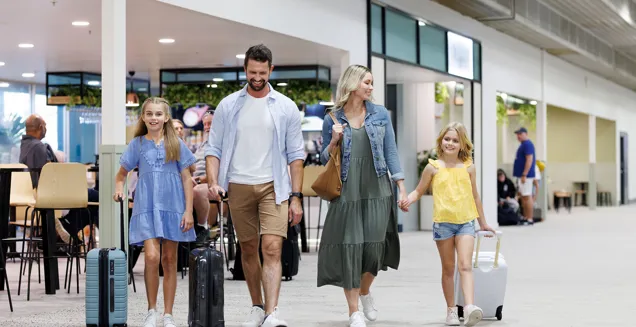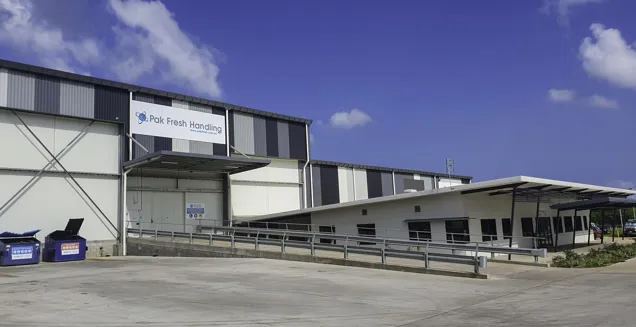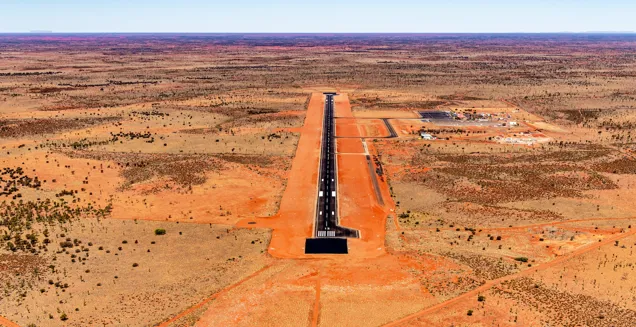North Queensland Airports Upgrade Project
NAIF’s loan of up to $155 million will be used to upgrade key infrastructure at Cairns and Mackay airports.
April 2024
Transport & Logistics
Cairns and Mackay, Queensland

NAIF has committed a loan of up to $155 million to North Queensland Airports to deliver major upgrades at Cairns and Mackay airports. These works will modernise international and domestic terminal facilities, strengthen critical Airside Infrastructure, and create new commercial and aviation precincts.
About North Queensland Airports
North Queensland Airports (NQA) owns and operates Cairns and Mackay Airports, two of the region’s most frequented gateways. Cairns Airport connects travellers to the Great Barrier Reef, the Daintree Rainforest, and destinations across Australia, Asia, and the Pacific, while Mackay Airport plays a central role in supporting regional connectivity and the resources sector. Together, they drive tourism, trade, and business development across northern Queensland.
As a privately held company, NQA focuses on sustainable growth, community partnerships, and environmental responsibility. Its airports support thousands of jobs, contribute significantly to regional economies, and continue to invest in infrastructure upgrades that improve connectivity, strengthen safety, and deliver lasting benefits for local communities.
Project overview
NAIF is providing NQA with a loan of up to $155 million to upgrade Cairns and Mackay Airports.
At Cairns Airport, the first major project involves refurbishing the International Terminal (T1 Upgrade). This marks the first significant upgrade to the terminal in 30 years and includes expanding its footprint, enhancing the departure lounge and baggage reclaim hall, upgrading baggage handling and security systems, and improving retail and bathroom amenities.
Another critical project at Cairns Airport is the overhaul of Airside Infrastructure. This involves replacing critical taxiways serving both domestic and international terminals. Replacement overlays will accommodate increased airport capacity and support projected growth for the next 15-20 years. Additionally, new power cabling around the runway will reduce maintenance downtime, ensuring safe operations.
The Eastern Aviation Precinct (EAP) is another significant endeavour at Cairns Airport. Executed in two stages, this project will increase aero stand capacity in the first stage to support increased activity at the domestic terminal. The second stage will establish three commercial lots, a designated heliport zone, and connecting access roads and services to create a new general aviation precinct above the maximum 100-year flood level, facilitating growth for existing general aviation operators.
At Mackay Airport, a major project involves the complete overhaul of Airside Infrastructure. This entails a planned overlay of the entire runway. Additional sections of taxiways and aprons will also be overlaid to reduce maintenance downtime and ensure continued safe operational standards.
The Milton Street Precinct project at Mackay Airport will deliver enabling infrastructure to a greenfield leasehold site within the airport boundary. Located close to the central business and industrial districts of Mackay, this project includes constructing roads and connecting services to create 25,000 square meters of serviced lots for a mix of retail and commercial businesses.
How We Helped
We provided concessional finance with a longer loan tenor and flexible terms. This support enabled North Queensland Airports to progress upgrades at both Cairns and Mackay airports, ensuring these critical regional gateways can continue to meet the needs of passengers, airlines and industry.
Our role included de-risking the project by structuring finance to align with the long-life nature of airport infrastructure, while also encouraging private sector investment by providing early confidence to proceed.
Through this support, the Cairns and Mackay airport upgrades are delivering modernised, reliable facilities that enhance passenger experience, improve connectivity, and strengthen the long-term growth of tourism and trade across North Queensland.
Public Benefit
An independent assessment by AEC concluded that NAIF’s loan of up to $155 million to support capital works at Cairns and Mackay airports will deliver significant public benefit, with an estimated $1.4 billion in total benefits over the life of the loan. The projects are forecast to generate $437.2 million in Gross Regional Product (GRP) for the North Queensland economy during construction and the first ten years of operations, supporting 290 construction jobs and 1,528 ongoing operational jobs. In total, 2,002 direct and indirect jobs are expected across construction and operations.
Upgrades at Cairns include the Terminal 1 Upgrade, Eastern Aviation Precinct and Airside Infrastructure Project, enhancing passenger capacity, reducing operational disruption and safeguarding tourism. At Mackay, the Airside Infrastructure Project reduces the risk of runway closures that could disrupt mining sector activity and regional workforces. Together, these works strengthen connectivity, support local businesses through construction spend, and ensure reliable, modern facilities that deliver long-term benefits to North Queensland communities and industries.
“This loan recognises our airports’ critical roles across the Cairns and Mackay regions, contributing to tourism, freight, business, the resources industry and more. We are grateful for this support from the NAIF and look forward to showcasing these enhancements to locals and visitors.”
Cairns Airport Chief Executive Officer Richard Barker
Related links
Indigenous Engagement
- The Djabugay Nation (comprising the Djabugay, Bulway, Yirrganydji, Nyakali and Guluy Peoples) and Yuwi peoples
Cairns Airport is located on Djabugay Nation ancestral lands. The Djabugay Nation, comprises the Djabugay, Bulway, Yirrganydji, Nyakali and Guluy peoples who are the Traditional Owners of a culturally and ecologically rich region in Far North Queensland. Their ancestral Country spans a diverse landscape of tropical rainforests, river systems, mountain ranges, and coastal zones, including areas in and around what is now known as Cairns and the surrounding ranges and waterways. The landscapes are ecologically and spiritually significant, holding sacred sites, creation stories, and traditional knowledge passed down through generations. Each of the five groups within the nation shares responsibility for caring for Country, preserving language and customs, and maintaining strong community ties. As the gateway to Cape York and the Torres Strait, Cairns serves as a significant meeting place for First Nations peoples across the region and is a hub for cultural events, health services, and community connection.
Mackay, on Queensland’s central coast, is located on the traditional lands of the Yuwi people, who are the recognised Traditional Owners of the region. Yuwi country lay between the O'Connell River to the north of Mackay, to Cape Palmerston in the South, west to the base of the Connor and Clark Ranges and the east encompassing the waters off the mainland between the north and south boundaries. Yuwi Country spans a rich and diverse landscape, including coastal plains, river systems such as the Pioneer River, wetlands, rainforests, and parts of the Great Barrier Reef and nearby islands. These ecosystems hold deep cultural and spiritual significance and are home to diverse flora and fauna. The Yuwi Aboriginal Corporation acts on behalf of the Native Title holders, supporting cultural heritage protection, land and sea management, and community development. The Yuwi people continue to practise and share their cultural knowledge through language, stories, and traditional ecological practices that reflect their ongoing custodianship of both land and sea country.
Indigenous Engagement Strategy Commitments
- Committed to ongoing engagement with Cairns and Mackay Traditional Owner groups and stakeholders and showcasing First Nations culture through rotating terminal art displays and commissioned artworks.
- Committed to supporting First Nations businesses and aiming to increase First Nations employment from 3% to 6% by FY2026/27, with additional commitments to internships, traineeships, graduate roles, and financial support to strengthen employment pathways in aviation and related industries.
- Maintain their partnership with Dawul Wuru Aboriginal Corporation supporting land and sea country.
- The Indigenous Engagement Strategy (IES) will be reviewed biennially with Traditional Owners and stakeholders and to reported annually to both the NQA Board and Traditional Owners to ensure transparency and accountability.
Indigenous Engagement Strategy Outcomes
- In 2025, NQA’s first Indigenous Engagement Strategy (IES) progress report shows progress across key commitments. Initial outcomes include three First Nations trainees commencing in June 2025, and a new scholarship program with CQUniversity was launched, offering $5,000 annually as well as work placements. NQA worked with the Yuwi Aboriginal Corporation in naming streets in the Milton precinct in language, Bandala (sky) and Guwari (wind).


